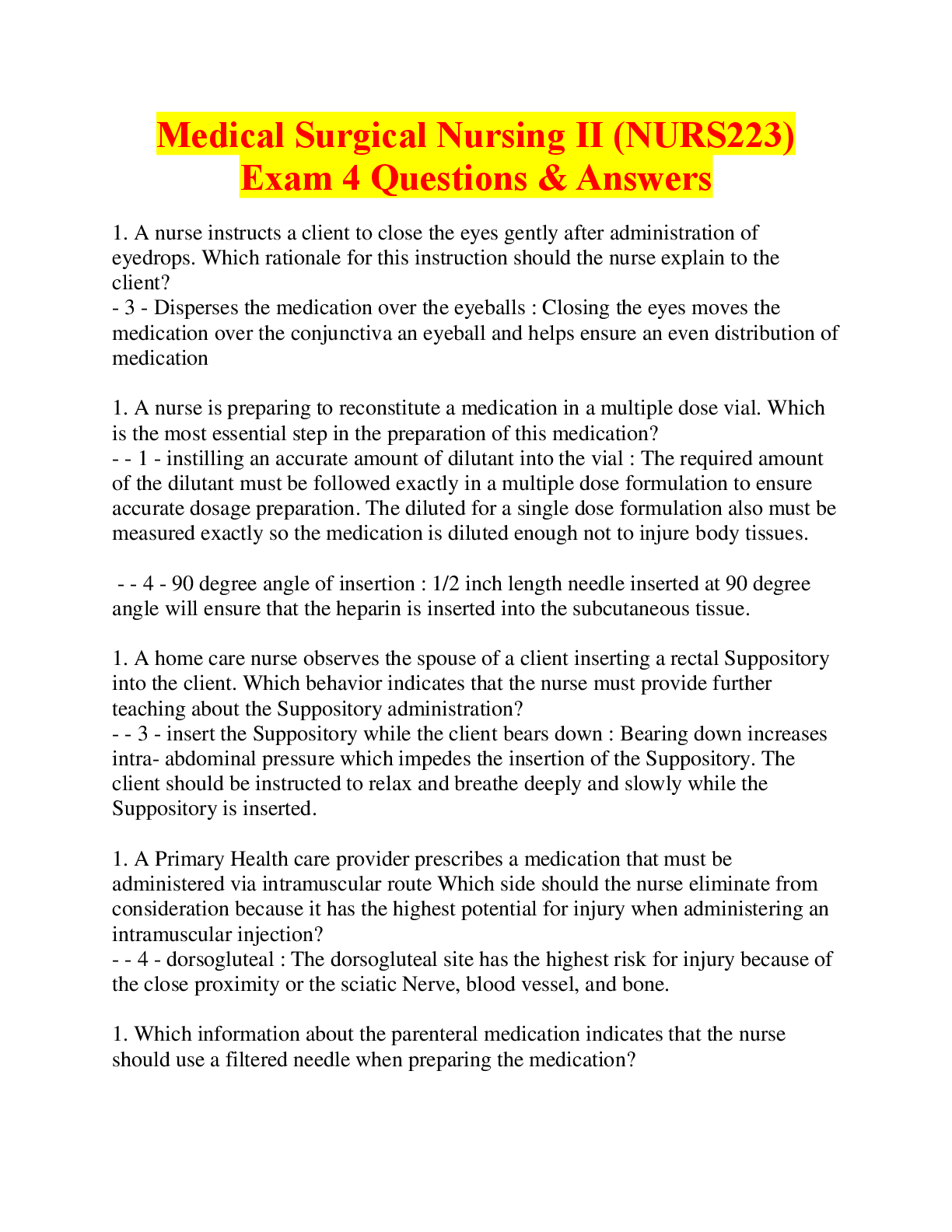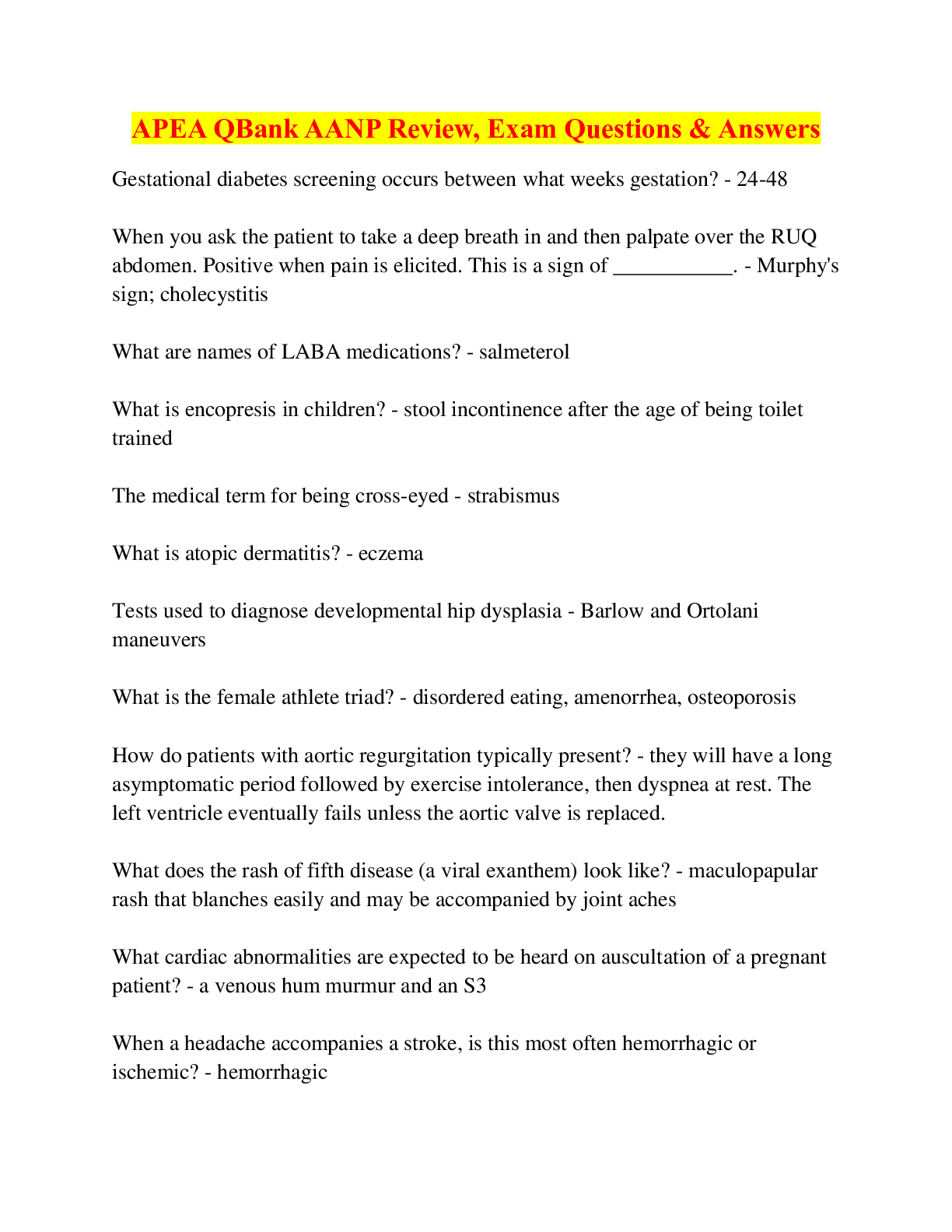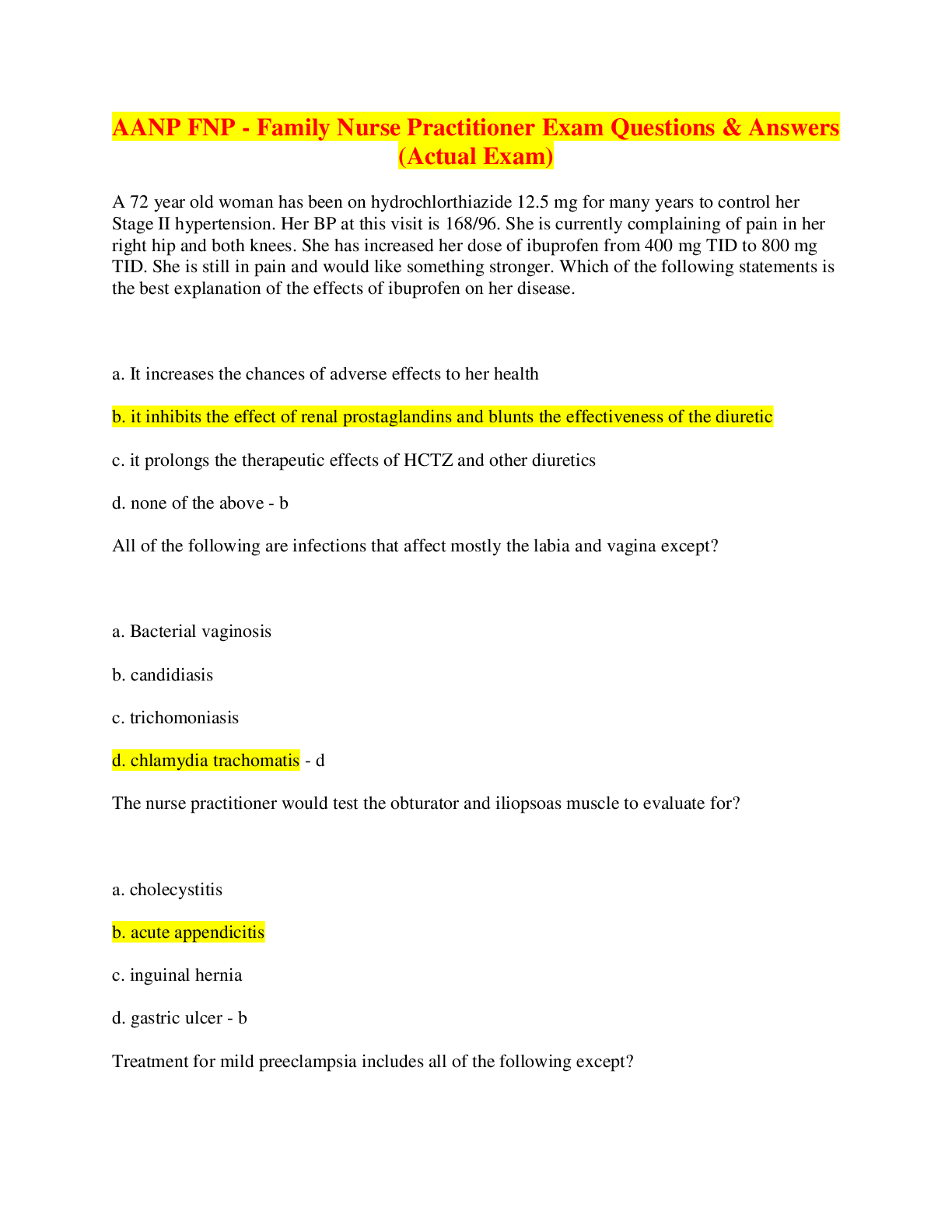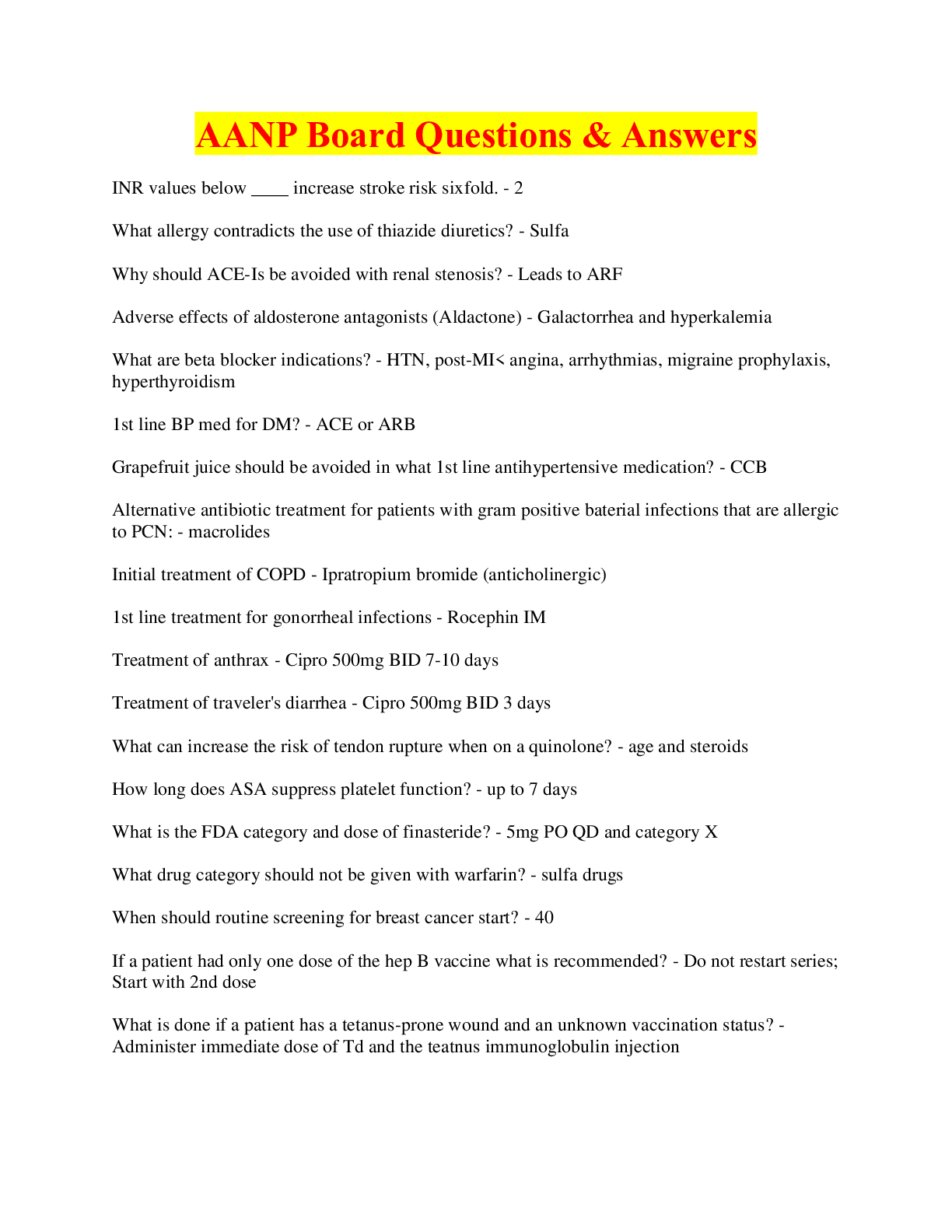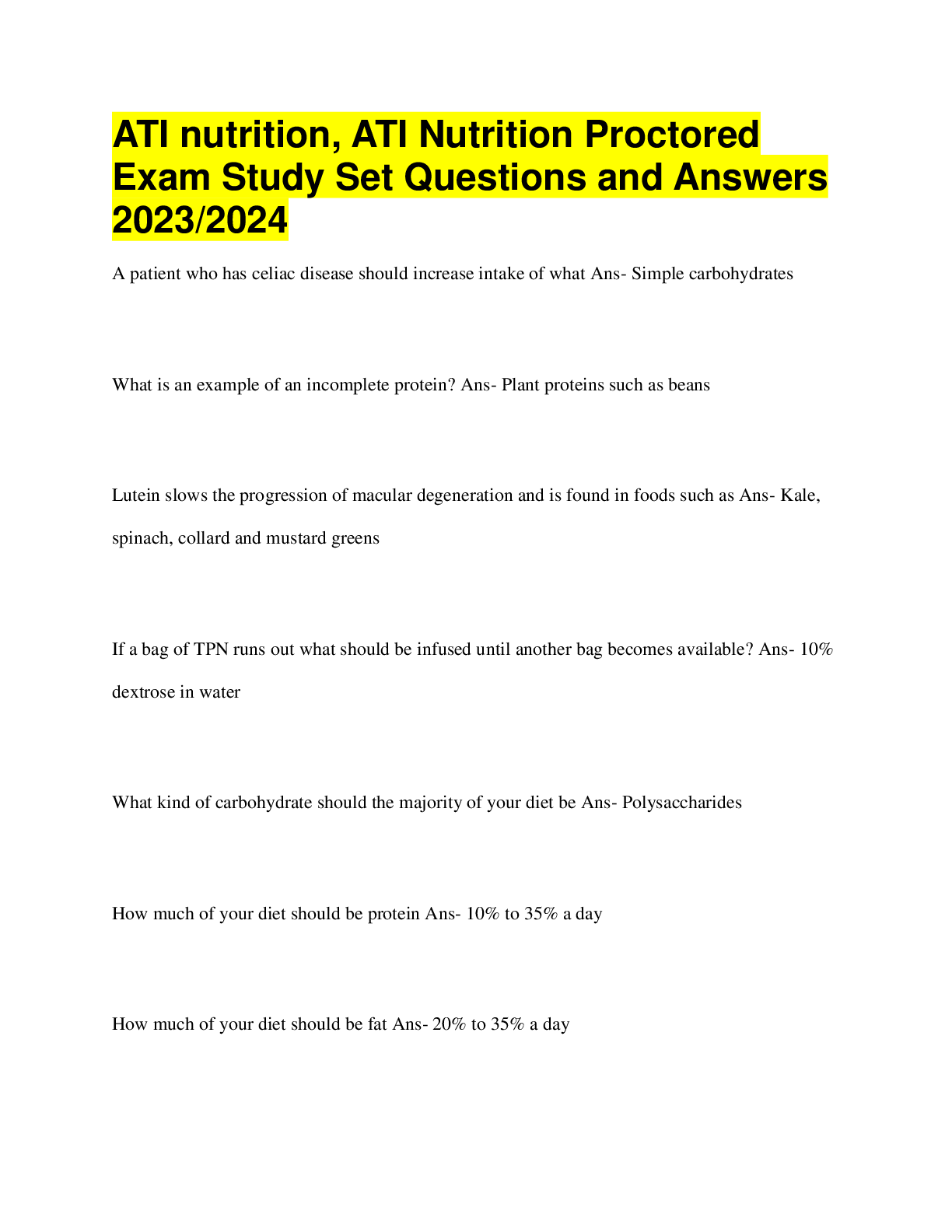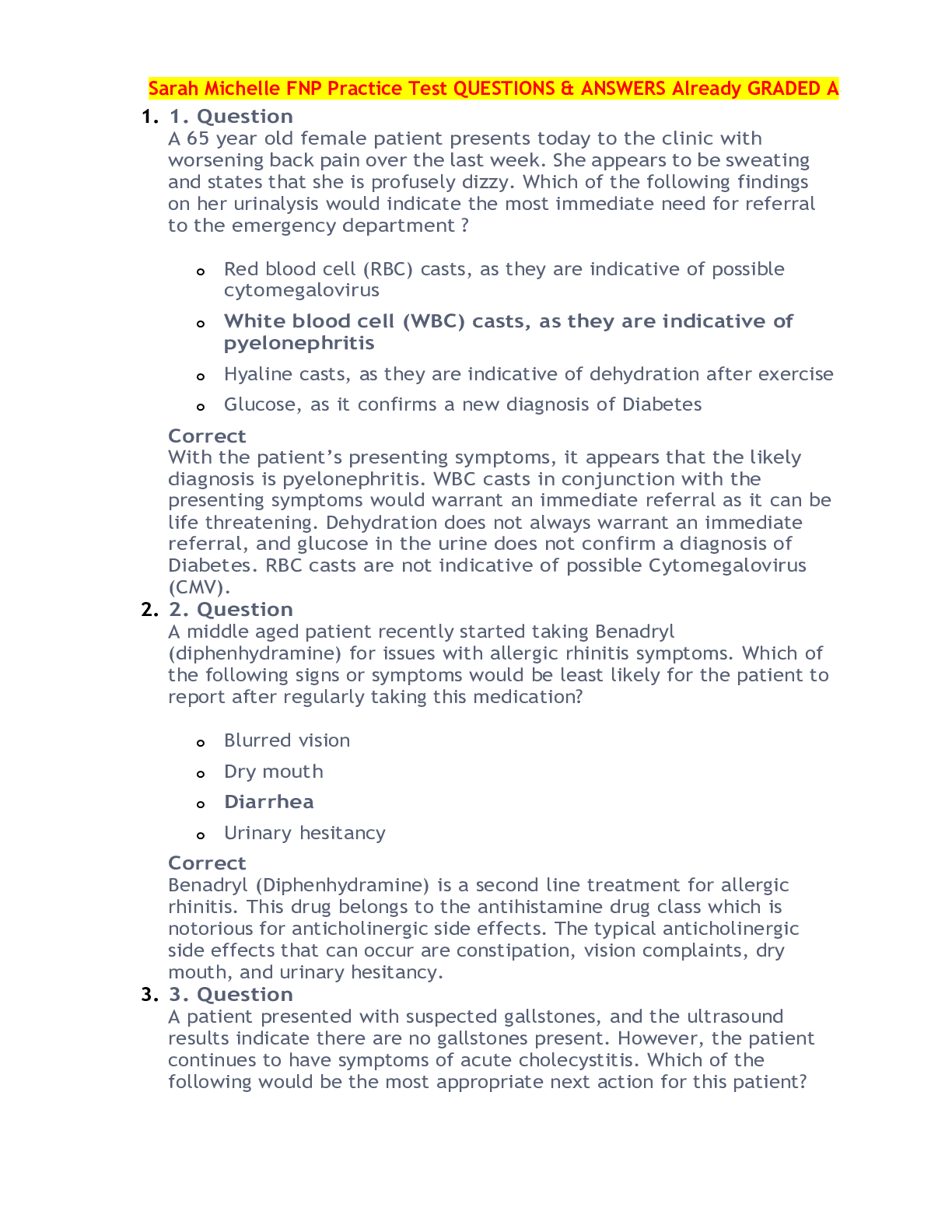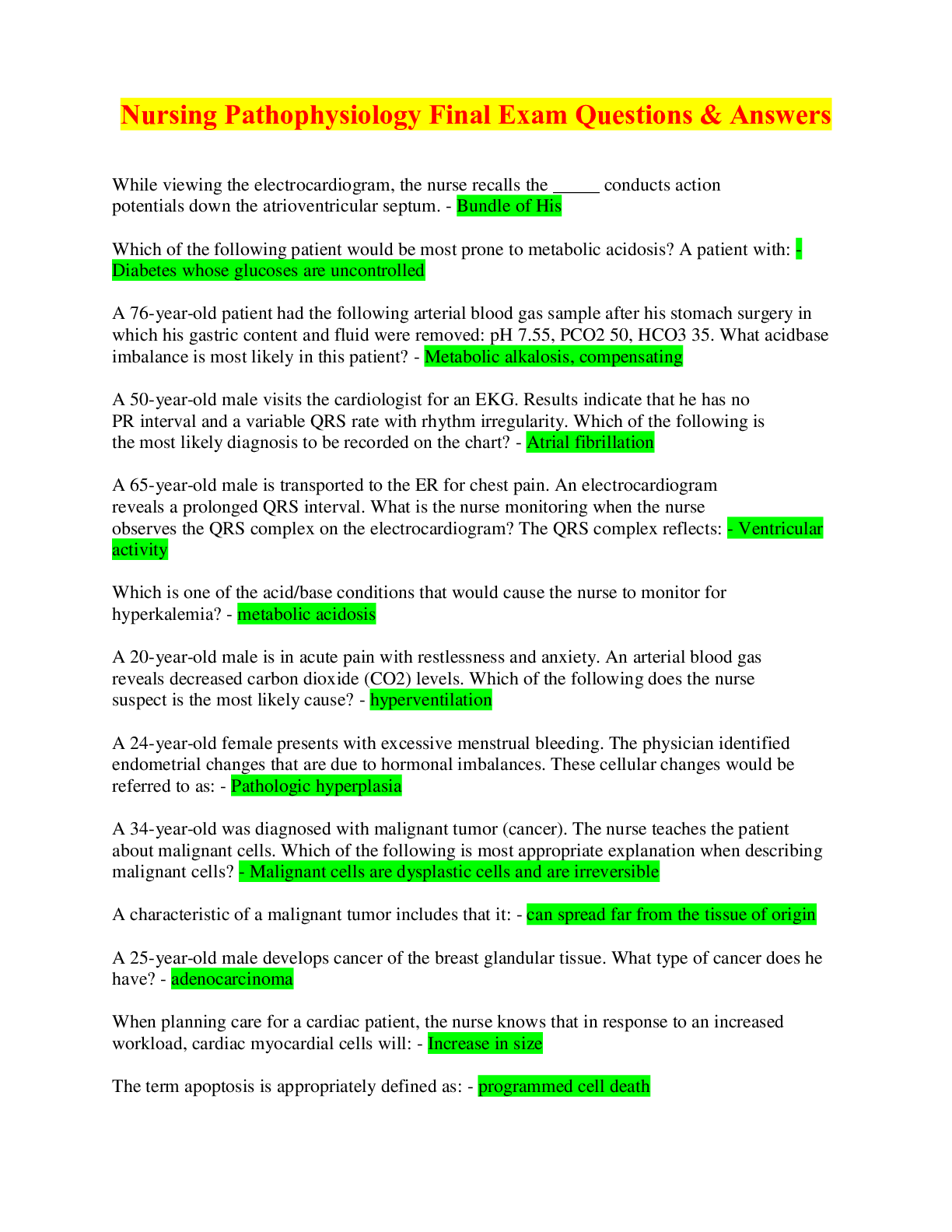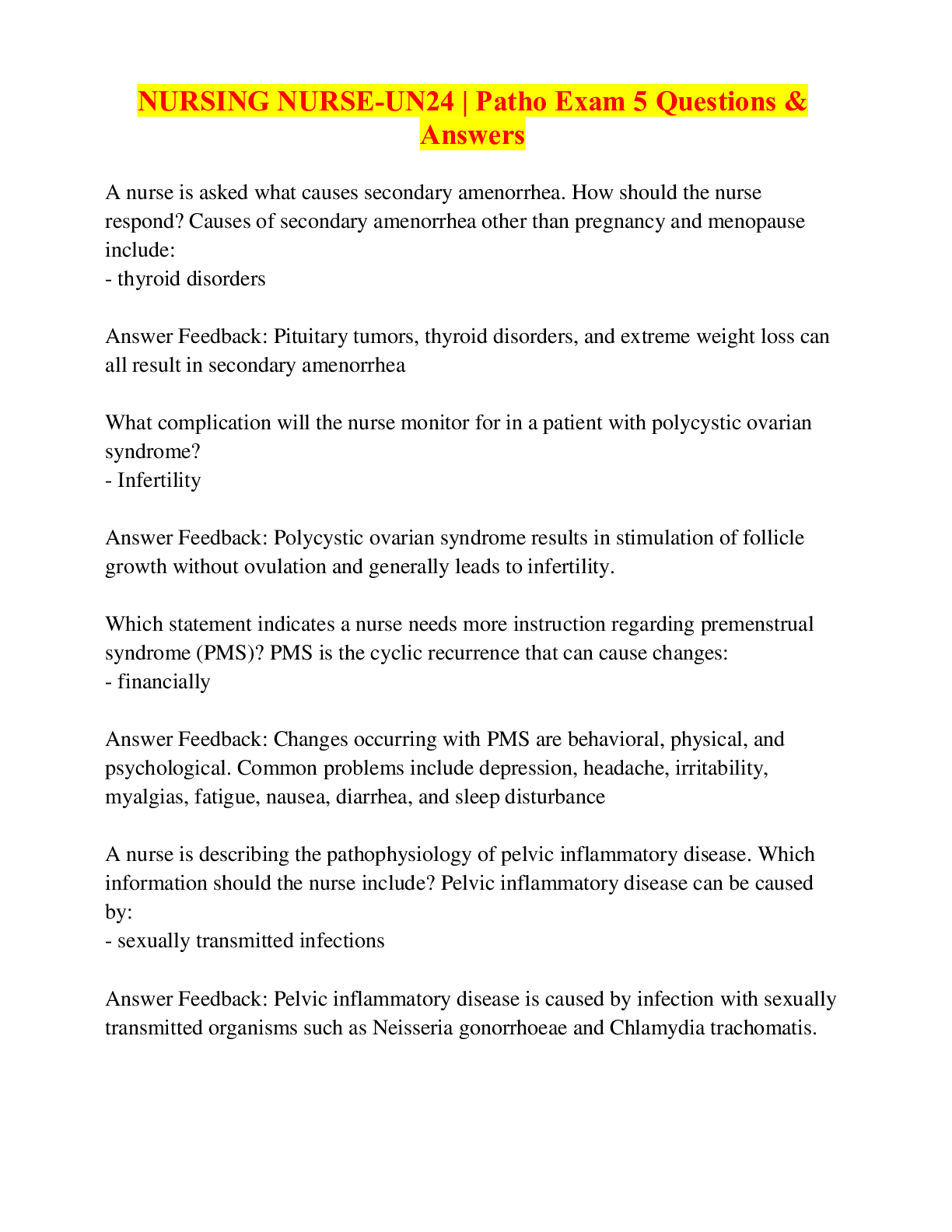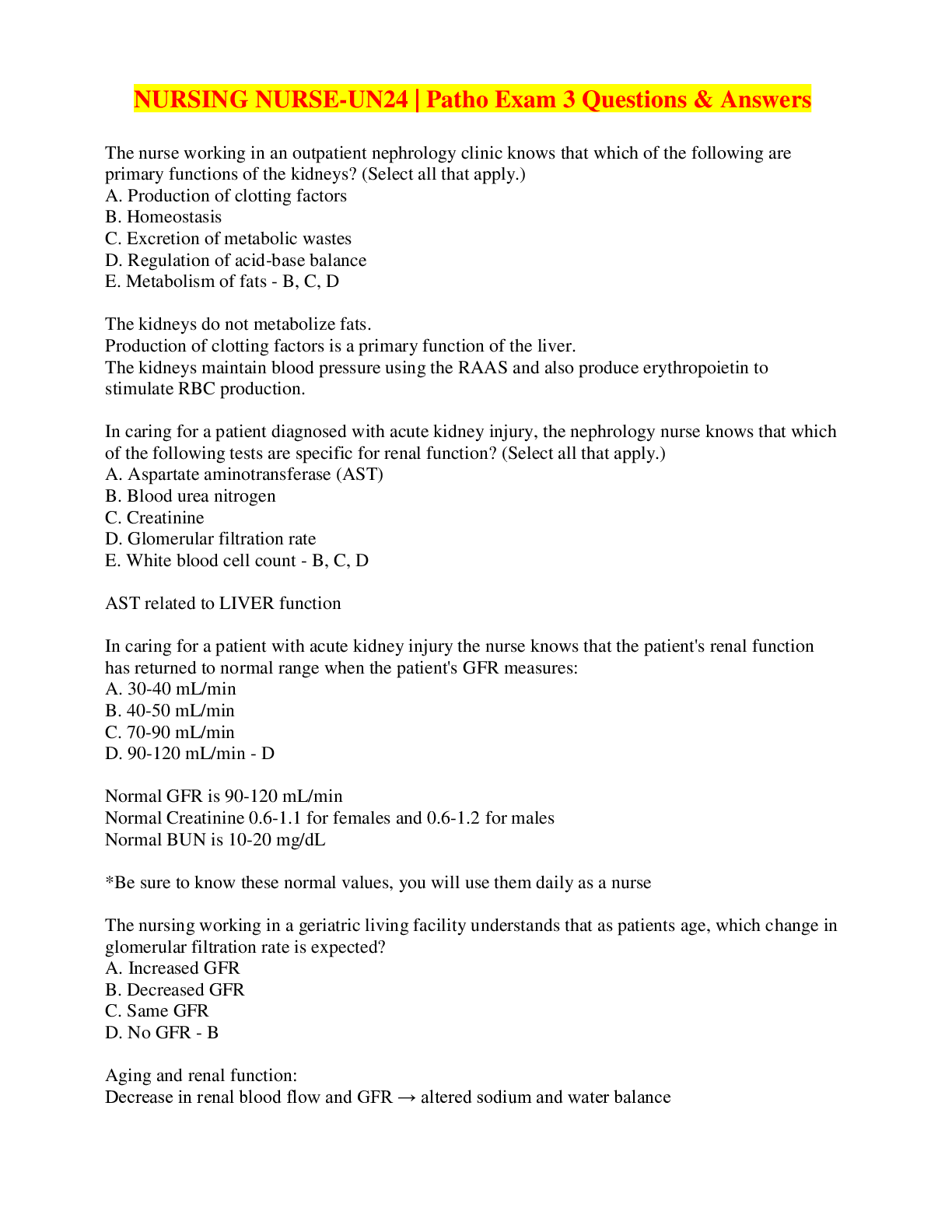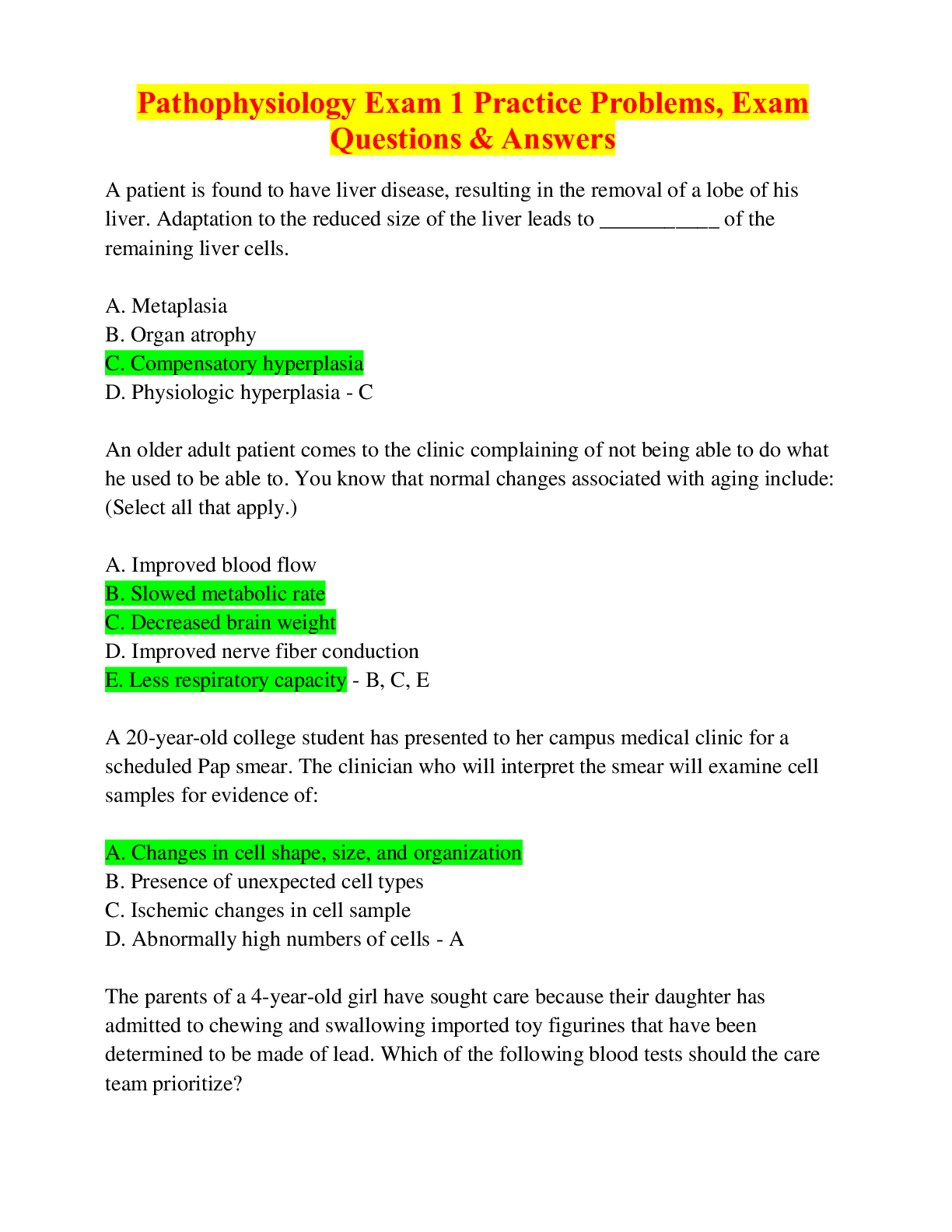All Documents for ATI Comprehensive Predictor A+ Guide, Answered
Document Content and Description Below
All Documents for ATI Comprehensive Predictor A+ Guide/All Documents for ATI Comprehensive Predictor 1. A nurse in a LTC facility notices a client who has Alzheimer’s disease standing at the exit d... oor at the end of the hallway. The client appears to be anxious & agitated. What action should the nurse take? ANS: Escort the client to a quiet area on the nursing unit. - A client c Alzheimer experiences chronic confusion. Guiding the client to a quiet, familiar area will help decrease agitation. They will be unable to follow instructions/commands. 2. A nurse is assisting with the plan of care for a client who has a continent urinary diversion. Which intervention should the nurse plan to implement to facilitate urinary elimination? ANS: Use intermittent urinary catheterization for the client at regular intervals. - A continent urinary diversion contains valves that prevent urine from exiting the pouch; therefore, the nurse should plan to insert a urinary catheter at regular intervals to drain urine from the client’s pouch. 3. A nurse is assisting with an education program about car restraint safety for a group of parents. Which statement by the parent indicates an understanding of the instructions? ANS: “My 12YO child should place the shoulder-lap seatbelt low across his hips.” - When a child is old enough to only use a shoulder-lap seatbelt, he should place it low across his hips rather than over the abdomen to reduce risk for injury during motor vehicle crash. 4. A nurse is reinforcing teaching about strategies to promote eating with a client who has COPD. Which instructions should the nurse include in the teaching? ANS: Drink high-protein and high-calorie nutritional supplements. - The nurse should instruct the client to drink high-protein and high-calorie nutritional supplements to maintain respiratory muscle function. COPD causes respiratory stress that leads to hypermetabolism and wasting of the client’s muscle mass. 5. When removing PPE after direct care for a client who requires airborne & contact precautions, which PPE is removed first? ANS: Gloves - The greatest risk is contamination from pathogens that might be present on the PPE; therefore, the priority action for the AP is to remove the gloves, which are considered the most contaminated. 6. A nurse is inspecting the skin of a newborn. Which finding should the nurse report to the PCP? ANS: Generalized Petechiae - Petechiae are an expected finding over the presenting part of the newborn, such as on the forehead in a brow presentation, & also anywhere on the head of infants who had a nuchal cord, w/c is an umbilical cord around the neck. However, petechiae all over the newborn’s body can indicate infection or decreased platelet count and should be reported to the provider. 7. A nurse is contributing to a teaching plan for a group of male adolescents about the A/E of anabolic steroid use. Which manifestations should the nurse include? ANS: Reduced height potential - Use of anabolic steroids in adolescence can lead to premature epiphyseal closure, thus reducing full height potential. A/E includes: Liver disorders, hyperlipidemia, breast enlargement, acne, and edema. 8. A nurse is reinforcing teaching with an older adult client who has severe L-sided HF. Which statement should the nurse make? ANS: Rest for 15 minutes between activities. - The nurse should instruct to increase his activity gradually & to rest for a period of 15 min if he becomes tired. Clients who have HF should balance activity c rest to reduce cardiac workload. 9. A nurse in a LTC facility is documenting the care of an older adult client. Which information should be included in weekly nursing care summary? ANS: Hydration Status - Older adult client are at risk for dehydration. Therefore, the nurse should be vigilant about monitoring the client’s hydration status & include this information in the weekly nursing care summary. 10. A nurse is caring for a client who has a head injury. Using the Glasgow Coma Scale to collect data, the nurse should obtain which information? ANS: Motor Response - The nurse should collect data about the client’s motor response & assign the response a score of 1-6, according to the Glasgow Coma Scale. 11. A home health nurse is reinforcing teaching with a client about the use of elastic stockings to decrease peripheral edema. Which instruction should the nurse include? ANS: Apply the stocking in the morning. - The nurse should instruct the client to apply the elastic stocking in the morning and remove them at the end of the day before bedtime. 12. A nurse is obtaining health hx from a client who is scheduled to undergo cardiac catheterization in 2 days. Which questions is the priority for the nurse to ask? ANS: “Do you know if you’re allergic to iodine?” - The greatest risk to the client is an allergic reaction to the contrast agent, which contains iodine. 13. A nurse is planning to administer nystatin oral suspension to a client who has oral candidiasis. Which instructions should the nurse give? ANS: “Hold the medication in your mouth for several minutes prior to swallowing” - The client should swish & hold the liquid in the mouth for at least 2 min to facilitate contact of the medication with the organism. The client should then swallow or spit out the medication. 14. A nurse is preparing to care for the assigned clients on her upcoming shift. Which time management strategies should the nurse plan to use? ANS: Prepare a priority list of client needs for the shift. - The nurse should prepare a client priority-to-do list, which could include administering time-critical medications. This will allow the nurse to determine which clients should receive care first. 15. After witnessing the consent, what action should the nurse take next? ANS: Ask client what he understands about the procedure. 16. Which task should the nurse assign to an AP for a pt 2 days post-op ff Total knee arthroplasty? ANS: Reapply antiembolitic stockings to the client ff a shower. 17. A nurse is reinforcing teaching with a client who is receiving radiation therapy for cancer of the larynx. Which statement made by the client indicates understanding of the teaching? ANS: “I will wear a soft scarf around my neck when I am outside” - Wash it with plain water without soap. NO heat source therapy. Only use electric razor if necessary, for shaving. 18. A nurse is using FLACC scale to determine the level of pain for an 11-months-old infant who sis port-op. Which factor should the nurse consider when using this pain scale? ANS: Level Of Activity - The nurse should consider the infants level of activity when using FLACC pain scale. The FLACC is determined by five categories of behavior: Facial Expression, Leg Movement, Activity, and Consolability. 19. A nurse is collecting data from a 5YO child at a well-child visit. Parent reports that the child is having frequent nightmares. Which statements by the parents indicates to the nurse that the child Is experiencing sleep terrors rather than nightmares? ANS: “My child goes back to sleep right away.” - The nurse should realize that going back to sleep quickly is an indication of sleep terrors, rather than nightmares. A child who is experiencing nightmare has difficulty returning to sleep because of continued fear. 20. A nurse is assisting with the care of a school-age child immediately ff surgery. The child weighs 21.8 kg (48 lb) & has a chest tube applied to suction. Which finding should the nurse report to PCP? ANS: 250 mL of sanguineous drainage over the last 3 hr - More than 3 mL/kg/hr of sanguineous drainage occurs for more than 2-3 consecutive hr ff surgery. It indicates active hemorrhaging. 21. A nurse is reinforcing teaching with an older adult client who has osteoarthritis. Which instructions should the nurse include? ANS: Apply capsaicin cream 4x/day - Apply it topically to provide warmth & relieve joint pain. [Show More]
Last updated: 5 months ago
Preview 1 out of 25 pages
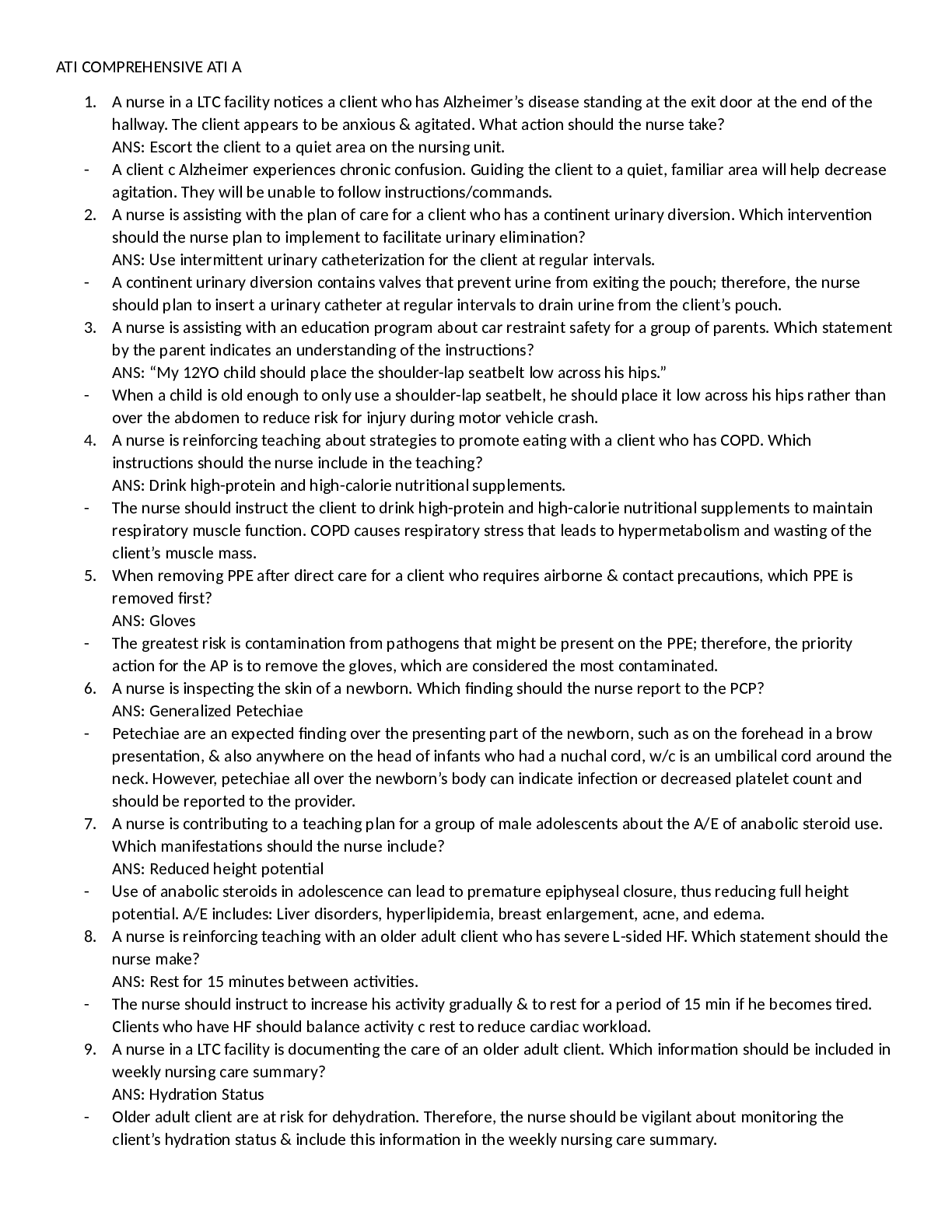
Buy this document to get the full access instantly
Instant Download Access after purchase
Buy NowInstant download
We Accept:

Reviews( 0 )
$15.00
Can't find what you want? Try our AI powered Search
Document information
Connected school, study & course
About the document
Uploaded On
Apr 17, 2021
Number of pages
25
Written in
Additional information
This document has been written for:
Uploaded
Apr 17, 2021
Downloads
0
Views
77

